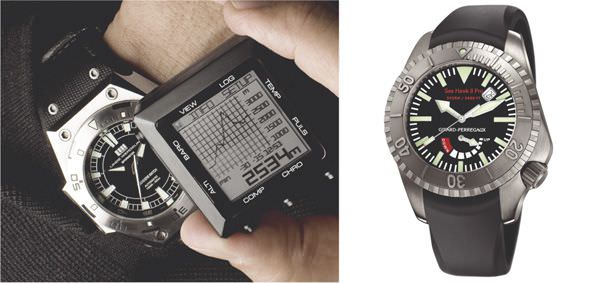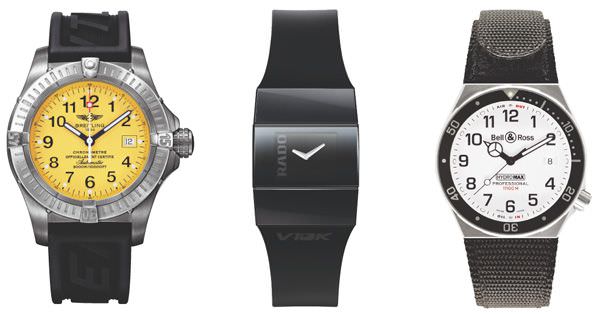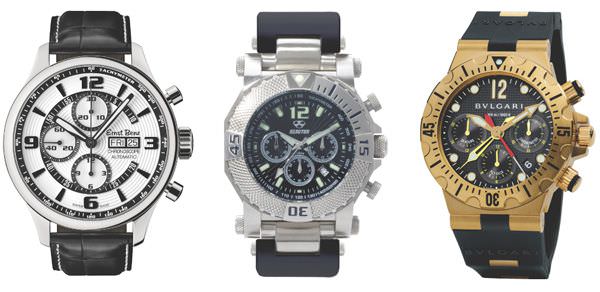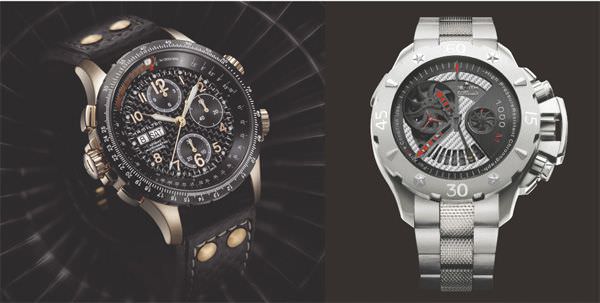There is a watch for just about every customer nowadays. Watches are continuing to get more specialized and one of the more interesting niche categories that is becoming increasingly popular is the ‘extreme’ watch.
How do we define extreme? How about a watch with such high specifications that customers will never even come close to exceeding its limits?
For example, it used to be that a watch with 200 metres of water resistance was the exception rather then the norm - pretty extreme and only designed for hardcore divers. Now, 200 metres is nothing compared to the water resist-ance of the Girard-Perregaux Seahawk II Pro (1,000 metres) or the Bell & Ross Hydromax 11100 M, which is water resistant to 11,100 metres - well over 36,000 feet.
Being extreme could be construction, with extra shock absorption (like Jaeger-LeCoultre's Extreme World series); materials, like Rado's extremely hard watches that can't be scratched, even by a diamond; or Reactor's Never Dark, which uses a combination of Superluminova and Tritium to ‘outshine’ all other watches.
Zenith uses the term ‘Xtreme’ in its Defy series, so the watches have to live up to the designation, and they do, complete with 1,000 metres of water resistance, extra shock absorption and cutting edge materials.

BIFORMETER WATCH AND LAND INSTRUMENT by Linde Werdelin, SEA HAWK II PRO by Girard-Perregaux
Owning these watches is not unlike customers owning a Ferrari supercar or a MV Augusta F4 motorcycle - beautiful to look at and equipped with incredible engines that can hit unsafe speeds in the blink of an eye. The people who own these vehicles don't drive that fast, but they appreciate knowing that they can.

AVENGER SEAWOLF by Breitling, V10 by Rado, HYDROMAX by Bell & Ross
Customers
Who are the customers for these extreme watches? Who is going to fly high enough or dive deep enough to actually use these watches?
There are two basic customers for extreme watches: the avid sportsman who will really use the watch for its intended purpose - divers, hunters, surfers, white water enthusiasts, climbers, extreme skiers and more. Water resist-ance and shock absorption are two key needs for this customer. The second customer is someone who really likes the bold design characteristics of these watches and the simple fact that they do not have to worry about hurting them.

CHRONOSCOPE by Ernst Benz, NEUTRON by Reactor, DIAGONO PROFESSIONAL SCUBA CHRONO WATCH by Bulgari
Dedicated extreme watches
Specialists covet extreme watches, because they are designed specifically for their extreme activities. If your clients include serious surfers, one of the things you should have in stock is a tide watch (Corum's Admiral's Cup Tide Watch in the mechanical range; Reactor, Casio, Rip Curl and others in quartz), and that watch had better be accurate. In addition to being able to tell when low and high tides are, the watch has to have good water resistance because most surfers won't take off their watches when they go into the water.
Have any mountain climbers or skiers in your customer base? You will need to stock watches with altimeters and barometers on them, so they can keep track of how high they are and note any changing weather patterns.
How about divers? There are a ton of great new diving watches, including a complete range from Jaeger-LeCoultre, Panerai, Breitling, Rolex, Citizen, Doxa and more that are perfect for serious diving. Most diving watches on the market have the specs for diving, but are really meant as a back up to external dive computers. These watches may never see the Titanic, but they can be used on casual dives, snorkelling, surfing, swimming and much more.
Divers don't normally go deeper than the recommended maximum depth for SCUBA, 40 metres or 130 feet, but watch companies continue to push water resistance even further. These watches can survive, and keep ticking, in depths that would crush and kill a human being like a soda can.
If your customers are in the market for a competent diving watch, make sure you stock timepieces that are at least 200 metres water resistant, as they will need that if they plan on swimming with their watch on.
Many of these multi purpose dive watches also feature a chronograph, one of horology's most useful complications. Some dive watches now have chronographs that can be activated underwater (Omega and Bulgari, for example), something that you are warned against doing with most chronographs, as the operation of the pushers can compromise water resistance.
The point of an extreme watch is the capability it provides, even if it is never used.

KHAKI X-WIND by Hamilton, DEFY XTREME by Zenith
Extreme watches, everyday wear
Today's extreme watches are attractive enough to be your customers' every day watch. Unlike the past, when sports watches were ugly, black plastic affairs, these new extreme watches look great. When a category gets hot, major manufacturers get involved, unleashing their research and development and design teams.
Many times, it's about bragging rights, having the features that qualify as extreme. Will anyone ever need a 1,000-metre depth rated watch? No, but in order to withstand this type of pressure the watch needs to be constructed differently than other watches. And it stands to reason that this makes the watch more durable in the longterm.
Customers of these extreme watches prob-ably want to wear their watches 24/7. They can wear these watches to the office, then get up on Saturday morning and spend the day doing their favourite sport and then wash off the salt water or dirt and feel just as proud and comfortable showing their watch off at the local night club.
Extreme watches are both a fashion and a lifestyle statement, but with the muscle behind them to rise up to just about any challenge. Customers love knowing that their watches can do just about anything and have made the ‘extreme’ watch its own category.
Source: Europa Star February-March 2008 Magazine Issue




